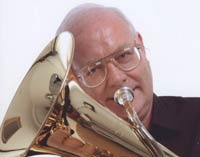Charley Brighton & Helen Hobson
3-Sep-2009Euphonium Recital No 35
St Marys Parish Church,
Slough
Saturday 22nd August
 Charley Brighton and his accompanist Malcolm Stowell have been giving recitals as part of the series of free lunchtime concerts at St Mary’s Church in Slough since 2001.
Charley Brighton and his accompanist Malcolm Stowell have been giving recitals as part of the series of free lunchtime concerts at St Mary’s Church in Slough since 2001.
During that time they have performed 72 premieres, and featured a wide range of instruments from Charley’s own collection of vintage brass.
Over 60 people attended the 35th recital, which was billed as Charley’s last as a single man prior to his wedding next month to long-time partner Susan Vel, a fine baritone player in her own right. Amongst those present was euphonium legend Trevor Groom, who had driven down from the Midlands.
Bassoon Concerto
The programme consisted of a mixture of transcriptions and original works, commencing with the “Finale – polacca” of a bassoon concerto by Franz Ignaz Danzi, probably best known for his wind quintets.
The opening was notable for Charley’s smooth tone (playing on his Wilson 2900) in the relaxed introduction. The music gradually became more intricate, with more ornamentation and decoration, both for the soloist, playing largely in the upper register, and also for the pianist.
There was some fine sotto voce playing before the work closed with arpeggios and scales across the whole range of the instrument.
From trombone to euphonium
Helen Hobson was playing trombone with the Central Band of the Royal British Legion when the band lost its two euphonium players. Having taught herself to play euphonium initially, she has since been taking lessons with Charley as she found some of the parts she was asked to play were getting too technical.
Helen joined Charley in an arrangement of “Deep inside the Sacred Temple” (Bizet), based on a transcription by Keith Wilkinson.
Playing on two Boosey & Hawkes Imperial Euphoniums, Charley’s an earlier model and Helen’s one of the last to be produced, the instruments blended quite well together, although there were one or two intonation issues. Helen is the latest of a number of pupils Charley has encouraged by inviting them to participate in these recitals.
Hawkes Cavalry tuba
The next item represented something of a departure from the norm, as Charley took up a 1912 vintage Hawkes Cavalry Tuba to play the “Serenade” from Elgar’s “Wand of Youth” suite.
As the name would suggest, these tubas were designed specifically with the requirements of mounted bands in mind, with front-facing valves, although the fourth valve on this particular example would indicate that it was intended for orchestral use.
This is one of Charley’s more recent acquisitions, and restoration work has included fitting plastic guides to the valves, that now work very smoothly. The instrument’s mellow tone suited Elgar’s writing very well, with a low, rumbling bass note to close.
Euphonium and organ
Despite John Golland’s early death, he nevertheless provided the brass band movement with many fine, lyrical works, including the euphonium solo “Peace”, which Charley presented on a 5-valve 1905 Besson euphonium, accompanied by Malcolm on the church’s fine organ.
The combination proved very effective, with the choice of registration providing plenty of variety in timbre, without ever over-powering the smooth and sustained solo line.
World premiere
Their final item was the world premiere of a new suite for euphonium and piano by Joe Miserendino, an American composer who has written several works for Charley.
Entitled “A Summer Suite (Sunday afternoon in the Park)” each movement featured a different instrument. The opening “Waltz” showcased a 1888 Hawkes euphonium, very compact in design which almost appeared to be cuddled by the soloist.
It portrayed a lilting waltz as overheard from the bandstand, with effective use of rubato, although the high note at the end of the movement didn’t quite come of as intended.
The “Ballade” employed the trickiest of the instruments to control, a Highams model dating from 1890, with Charley having to constantly adjust the intonation. Nevertheless this whimsical movement worked well, with some neat interplay between piano and euphonium.
The finale, “Virtuosity”, used the modern Willson, Charley explaining that he needed all the help he could get! It made considerable technical demands from the outset, with double-tonguing and lively figurations.
A more sustained lyrical interlude led into more florid writing proving how apt the title was.
Following the recital many people gathered round to have a closer look at Charley’s collection of instruments, and even to have a blow for themselves.
With several more recitals already in the pipeline, plus appearances with various wind bands and chamber groups, it is clear that Charley is going to be kept quite busy in the coming days.
Peter Bale









